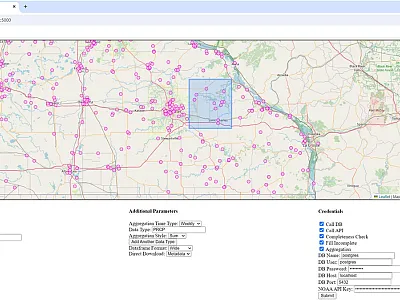Collaborative leadership in science
Pro tips for effective interdisciplinary teamwork

In their article, Morten et al. (2015) describe interdisciplinary work as work that crosses disciplinary boundaries and develops integrated knowledge. Interdisciplinary work can be incredibly impactful for society and the environment, and many scientists find it to be some of the most meaningful work they do. Over the past 10 years, I’ve gotten the chance to work on quite a few interdisciplinary projects, and I’ve made interdisciplinary work a big part of my career. In this article, I want to share some tips that may help you if you have similar goals.
But first, a disclaimer!
Disclaimer: some advice about advice
We all have different backgrounds, experiences, and aptitudes. What has worked for me may not necessarily work for you. When receiving advice from anyone, I encourage you to ask yourself whether there are key differences between their experience and yours, how much they know about your specific situation, and whether your goals align with theirs.
My background and disciplines
Since I’ve just said you should know who is giving you advice before you take it, here is a little bit about my professional journey. As a child, I loved animals and grew up gardening. These interests led me to study general agriculture at Kilgore Junior College, and I also took a student research job in soil fertility while in junior college. From there, I went on to earn my B.S. and M.S. degrees at Texas A&M University where I specialized in soil physics and pedology. Later, as a Project Manager at Texas A&M AgriLife Research, I worked across agricultural engineering, plant breeding, agronomy, animal science, and international development. It was at this job that I realized that much of the work I had done in my past would probably just be collecting proverbial dust because it wasn’t communicated to end users. This inspired me to go back and get my Ph.D. at Texas A&M University while expanding my expertise from soil physics to soil health, rural sociology, ecological economics, and natural resource economics. Today, as a Research Soil Scientist at the Soil Health Institute, my work incorporates soil physics, soil health, agricultural economics, education, management, and business. This breadth of experience has shaped my approach to interdisciplinary collaboration, and I hope some of the lessons I’ve learned can help you on your journey.
10 pro tips for effective interdisciplinary teamwork
1. Define your goals
The first step in successful interdisciplinary work is defining your goals. Do you want to work primarily within one discipline while collaborating with others, or do you want to fully embrace an interdisciplinary identity? Interdisciplinary work is challenging, so having a clear purpose will help you stay motivated and focused.
2. Select a strength
While interdisciplinary work requires breadth, you still need a deep area of expertise to secure employment and establish credibility. Employers seek specific skills, so having at least one area where you can compete at a high level is crucial. For example, if you are the third best agronomist in a pool of candidates for an agronomist position, it likely won’t matter that you are the best economist in the pool. You still need to be the best candidate in at least one area.
While interdisciplinary work requires breadth, you still need a deep area of expertise to secure employment and establish credibility.
3. Be prepared to work harder than the next person
This flows from the second tip because while you were honing skills in multiple disciplines, your peers might be able to focus on just one. This could very well mean you just have to work harder than they do. As well, some people may not understand the value of interdisciplinary research. For example, publishing in this space can be difficult. Reviewers don’t always recognize novel applications, and interdisciplinary work may not carry the same prestige as groundbreaking discoveries within a single discipline. But perseverance pays off. Some of the work that has been hardest for me to get through peer review has turned out to be the most well cited and impactful.
4. Be flexible
Flexibility is another essential quality. You need to articulate how you fit into a team because others may not immediately recognize the need for your skills. Being open to tasks outside your preferred scope can help you establish credibility and secure your place within a group.
5. Be willing to do entry-level work.
Even if it feels like a step backward, you may need to do entry level work. When I ventured into new fields, I often had to start with foundational tasks. Revisiting basic concepts has strengthened my understanding, and humility in these moments has ultimately helped me master multiple disciplines. For example, I was a pretty skilled soil scientist who was taking introductory-level classes in economics during my doctoral work. I was also reading sociology textbooks on the side because the classes I needed weren’t available in time.
6. Find a concrete task
Interdisciplinary work involves a lot of discussion, but action is key. Finding a concrete task—a research paper, a blog, a field day, or another tangible output—will help validate your contributions. Start as soon as possible and be prepared for extensive feedback from experts. During my doctoral work I found that writing drafts of papers was a good way to get things started. They took MANY revisions because I often misunderstood economic concepts, but making the mistake on paper motivated my coauthors to correct my mistakes. This way I learned, and we also all got deliverables for the project.

7. Curate and interpret
Curating and interpreting information is another critical skill. Today information is accessible to everyone, but true expertise comes from organizing and applying it effectively. AI and machine learning rely on data flow, but in areas where data is scarce, human analysis remains essential, especially in interdisciplinary collaboration.
8. Build a team that cares
Building a team that cares about interdisciplinary work is fundamental. Not everyone has the time or inclination to be interdisciplinary, and it may take years to find the right collaborators. Be gracious when team members come and go. Ensure that every team member benefits from the work, so the collaboration remains sustainable.
9. Be the glue
Sometimes, you have to be the glue that holds the team together. I’ve often found myself in this role, convening, coordinating, and maintaining momentum. Even great teams need someone to nurture cohesion and keep things moving forward. Be someone that all team members can talk to so that people feel heard and their ideas can flow.
10. Find joy
Finally, find joy in the process. Interdisciplinary work is some of the most meaningful and impactful work we can do. Staying grateful and enthusiastic will help sustain your motivation and energy over the long run. Personally, I feel incredibly fortunate to have been able to work and learn with so many incredible scientists, educators, and professionals. What keeps me going is that opportunity to contribute meaningfully to making the world a better place.
Summary
Interdisciplinary collaboration is challenging but deeply rewarding. To succeed, define your goals, establish a core strength, be willing to work hard, stay flexible, embrace entry-level work, take concrete action, curate and interpret information effectively, build a strong team, act as the glue that keeps it together, and most importantly, find joy in your work. By following these principles, you can navigate the complexities of interdisciplinary science and make a meaningful impact.
References
Morton, L.W., Eigenbrode, S.D., & Martin, T.A . (2015). Architectures of adaptive integration in large collaborative projects. Ecology and Society, 20 (4). http://www.jstor.org/stable/26270306
Dig deeper
Dianna Bagnall presented a webinar on this topic on March 12, 2025 as part of the Graduate Student Leadership Conference.
Register by April 2, 2025 to view the entire series.
Text © . The authors. CC BY-NC-ND 4.0. Except where otherwise noted, images are subject to copyright. Any reuse without express permission from the copyright owner is prohibited.







